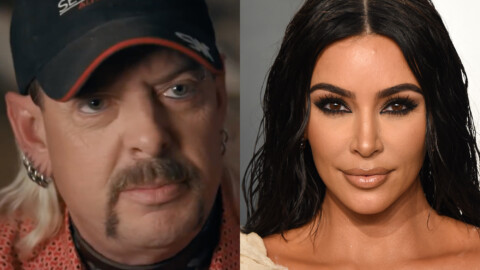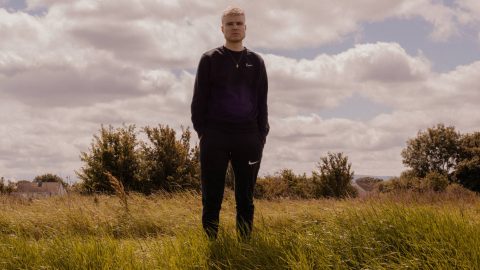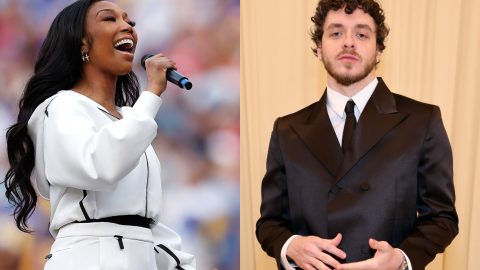
In 2000, sat in a pub with Alex James to discuss Fat Les’s seminal lager reworking of ‘Jerusalem’, talk inevitably turned to the possibility of a new Blur album. “Well,” Alex grinned, “once Damon’s finished with his monkey thing, we’ll see…”
It was the first I – or pretty much anyone – had heard of Damon Albarn’s “monkey thing”, and the more hints that leaked out over the coming months the more ridiculous it sounded. Like one of those ideas you and your mates dream up on the third night of a mescaline bender and, once you’ve had a week to sober up, one of them takes way too seriously. A cartoon band? With a Satanist bassist and a possessed drummer? Doing ‘zombie-hop’? It sounded about as likely to take off as my own off-my-cheesehole-at-4am idea for magic computer money.
When they arrived, Gorillaz certainly took a while to get our heads around. Tasked with writing their first NME cover interview in a manner that suggested I was running riot with the cartoon stars themselves rather than sat in a mundane West London studio with Damon and Jamie Hewlett, I went far too Roadrunner in my write-up, not yet realising that for all their fantastical antics and back stories (2-D’s comas, Russel’s demonic possessions, Noodle’s arrival from Osaka in a packing crate, Murdoc’s deal with the devil) Gorillaz’s dark surrealism had a slight but discernible accent on the ‘realism’.
These cartoons had criminal records, abusive childhoods and deep physical and psychological scars. Live, they were just as inscrutable: at their first gig at the Scala in London in March 2001, Damon and an undefined band performed behind a white screen stretched across the front of the stage, occasionally lit in shadow from behind during the melodica riffs. The novelty aspect was exciting, but you wondered just how long fans could watch still images of Gorillaz members floating across a white screen like comic book Pong before that novelty might start wearing as thin as Murdoc’s decimated denims.
Yet two decades on – as of last Friday (March 26) – from the release of the debut Gorillaz album, Damon’s still far from finished with his ‘monkey thing’. When the self-titled debut became a far bigger hit in America than any of Blur’s, for Albarn the madcap became a money-spinning mainstream. You can see why the concept of a virtual cartoon band to hide behind might appeal to a high-profile artist tiring of incessant press scrutiny in the wake of his break-up album, and keen to explore a wider sonic landscape with an array of new collaborators without having to do any photo sessions looking bored in studios with little-known American producers, or tediously dry interviews trying to explain who Del The Funky Homosapien is to fans of ‘Beetlebum’.
What’s really impressive, though, is how Damon evolved the project from an experimental receptacle for all the rhythms and sounds that didn’t fit on Blur records into an influential sonic melting pot. Pan-cultural star guests began to appear – Shaun Ryder, Roots Manuva, De La Soul, Snoop Dogg, Lou Reed, Mark E. Smith, Mos Def, Bobby Womack, Yukimi Nagano, Gruff Rhys, Neneh Cherry – making early Gorillaz albums virtual wormholes between indie rock and hip-hop. The relative anonymity allowed Albarn the no-strings freedom to indulge in whatever global textures and cutting-edge styles caught his fancy without the burden of responsibility: if you don’t like it… pffft – some cartoons did it.
It was, arguably for the first time ever, mainstream music made without either the limitations of genre or the expectations of persona, and its success threw open the floodgates of cross-pollination for millennial music. Before Gorillaz captured and updated the carefree crossover spirit of their early collaborators The Tom Tom Club, rock-rap was ‘Walk This Way’ or Limp Bizkit, ‘world music’ was Paul Simon or Sting and experimental electronic sounds strictly the territory of Radiohead, boring DJs with all the primary colour pizzazz of the average skip and obscure leftfield acts only ever pictured hiding glumly behind telephone poles.
After Gorillaz, the likes of Animal Collective, M.I.A., Vampire Weekend, MGMT, Goat and any act that ever let their singer bash on a snare drum during the loud bits revelled in their brave new sonic free-for-all. In an era where unrestrained musical connectivity is par for the course – The Flaming Lips working with Miley Cyrus, Taylor Swift with The National, Kanye West with Bon Iver – you could say Gorillaz were decades ahead of their time, if they hadn’t played such a large part in instigating it.
It elevated Albarn from a great artist to a historically important one. If Britpop proved he was capable of bending British culture to his will – or at least luring it down his chosen dog track – Gorillaz repeated the feat on a global scale. It also seemed to unleash him. Operas, musicals, soundtracks, art rock supergroups, Afrika Express, a solo album; without having his face on his primary project, he was free to scamper around a cornucopia of one-off projects without ever seeming over-exposed, one of the most influential, restless and pioneering artists of his generation. If Blur won the battle and Oasis won the war, Albarn himself won the Nobel Peace Prize.
20 years on, Gorillaz still feel difficult to get your head around. The recent spate of eclectic tracks released monthly as part of their ‘Song Machine’ project felt a bit like being the first one out of ammo in a paintball fight. Their accompanying livestream was a typically dizzying experience, featuring a hologram Beck dancing beside a golf buggy, a druid Matt Berry and a cartoon Elton John singing at a grand piano festooned with a hairy hand candelabra. When I finally got to chat to Murdoc and 2-D face to face on camera in 2017 (in an interview-this-empty-sofa-and-we’ll-do-the-rest sort of way), I thought I might get some clarity and insight into their shrouded mechanisms, ideas and inspirations. But they just told me their best prison stories and kept assuming I was Rick Astley, who’d let himself go.

It’s frustrating that the 20th anniversary of ‘Gorillaz’ only saw the band trending because they’d announced an environment sullying NFT auction despite having released the cautionary ecological satire ‘Plastic Beach’ in 2010 (note to bands: you can mint NFTs on blockchains that are hundreds of thousands of times more energy efficient than Ethereum – just saying). Because these wafery freaks are one of the greatest acts of the century so far, and I for one hope that Damon never gets finished monkeying around.
The post ‘Gorillaz’ at 20: how Damon Albarn’s virtual band shaped music history appeared first on NME.









